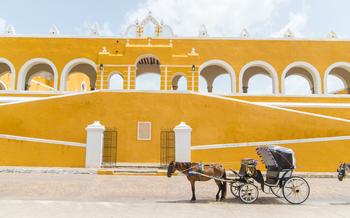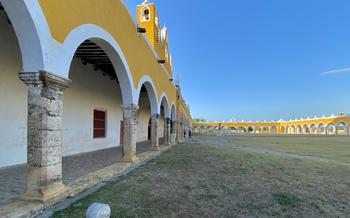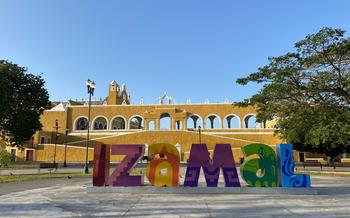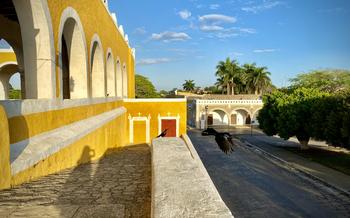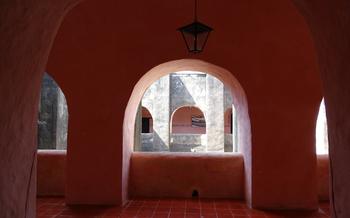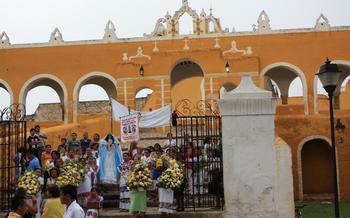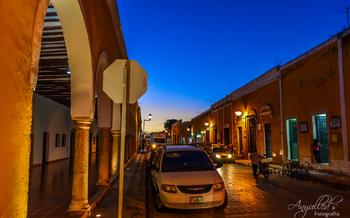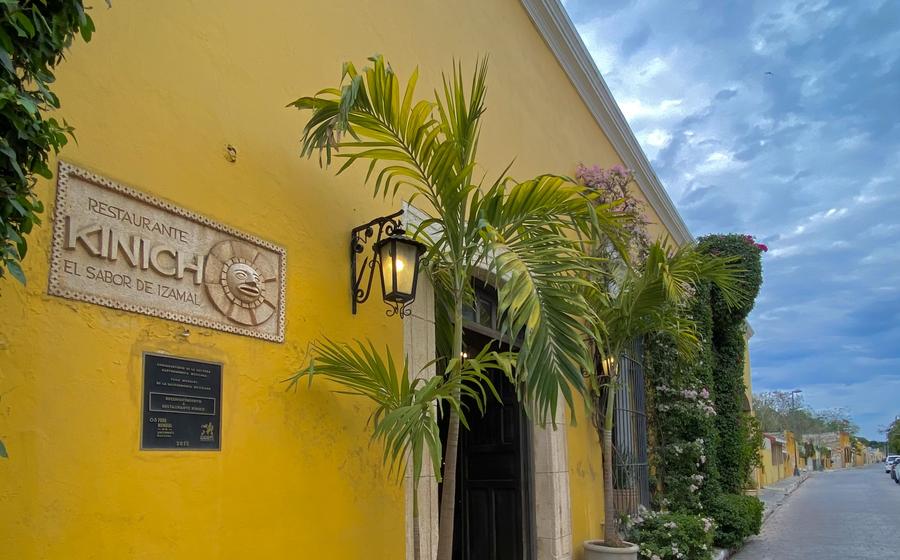
Grutas de Calcehtok (Nearby city)
- A Magical Town with a Unique Charm
- Grutas de Calcehtok: A Hidden Gem
- Exploring the Caves
- History and Legends
- Conservation Efforts
- Practical Information
- What to Bring
- Nearby Attractions
- Local Cuisine
- Festivals and Events
- Shopping and Souvenirs
- Accommodation Options
- Getting Around
- Insider Tip: An Unforgettable Experience
A Magical Town with a Unique Charm
What is Izamal? Izamal is a captivating town located in the Yucatán Peninsula of Mexico, renowned for its striking colonial architecture, vibrant culture, and proximity to various natural wonders.
Why is it worth visiting? Izamal's allure lies in its well-preserved colonial heritage, exemplified by its stunning yellow buildings, cobblestone streets, and iconic Franciscan convent, which dominates the town's central plaza. The town's rich history, dating back to pre-Hispanic times, blends seamlessly with its contemporary charm, offering visitors a glimpse into Mexico's diverse cultural tapestry.
What makes it unique? The town's most distinctive feature is its uniform yellow hue, earning it the nickname "Ciudad Amarilla" or "Yellow City." This unique characteristic stems from a local tradition that began in the 16th century, when the town's buildings were painted yellow to celebrate the visit of Pope John Paul II. The tradition has endured, and today, Izamal proudly maintains its vibrant yellow facades, creating a picturesque and unforgettable townscape.
Grutas de Calcehtok: A Hidden Gem
The Grutas de Calcehtok are a series of interconnected caves located near the town of Izamal, in the Yucatán Peninsula of Mexico. These caves are a hidden gem, off the beaten path and waiting to be explored. They offer a unique and unforgettable experience for those who love nature, adventure, and history.
The Grutas de Calcehtok are formed by a complex system of underground tunnels and chambers, carved out by the action of water over millions of years. The caves are home to a variety of speleothems, including stalactites, stalagmites, columns, and flowstones. These formations come in a variety of shapes and sizes, creating a surreal and awe-inspiring landscape.
What makes the Grutas de Calcehtok truly special is their connection to the ancient Mayan civilization. The Mayans believed that caves were sacred places, portals to the underworld. They used the caves for religious ceremonies, burials, and water rituals. Evidence of Mayan activity has been found in the caves, including pottery shards, stone tools, and skeletal remains.
Exploring the Caves
Venturing into the Grutas de Calcehtok is like stepping into a hidden world of natural wonders. The caves are a labyrinth of chambers, tunnels, and subterranean rivers, each revealing its own unique features. As you descend into the depths, the air becomes cooler and the darkness envelops you, creating a sense of awe and mystery.
The journey through the caves begins with a guided tour, led by experienced local guides who share their knowledge of the caves' history, geology, and ecology. Equipped with headlamps and sturdy shoes, you'll navigate narrow passages, admire towering stalactites and stalagmites, and marvel at the intricate rock formations that have been shaped by water and time.
Some of the highlights of the caves include the "Salon de las Columnas," a vast chamber adorned with majestic columns that resemble ancient ruins, and the "Cenote de la Virgen," a crystal-clear cenote that invites you to take a refreshing dip in its pristine waters. The caves also feature a variety of wildlife, including bats, spiders, and insects that have adapted to the unique environment.
History and Legends
The Grutas de Calcehtok hold a significant place in Mayan history and culture. Ancient Mayans used these caves for various purposes, including religious ceremonies, water collection, and shelter during times of conflict. Archaeological evidence suggests that the caves were inhabited as early as the Pre-Classic period (2000 BC - 250 AD).
The caves are entwined with numerous legends and myths, passed down through generations by the local Mayan communities. One of the most prominent legends tells the tale of a hidden city deep within the caves, where the Mayan gods once resided. According to this legend, the city was protected by powerful spirits who guarded its secrets from outsiders.
Another legend speaks of a hidden treasure buried within the caves, left behind by the ancient Mayans as an offering to their gods. Many have ventured into the caves in search of this treasure, but none have ever succeeded.
The Grutas de Calcehtok played a crucial role in Mayan culture, serving as a sacred site for rituals, ceremonies, and spiritual connection with the underworld. The intricate cave systems, with their natural formations and hidden chambers, were believed to be gateways to the realm of the gods, where shamans and priests sought guidance and communicated with the supernatural.
Conservation Efforts
Protecting a Natural and Cultural Treasure
The Grutas de Calcehtok are a valuable natural and cultural heritage site that requires conservation efforts to ensure their preservation for future generations. The caves face various threats, including human activities, climate change, and natural erosion.
Preservation Initiatives
To address these challenges, several conservation initiatives are underway. The local community, in collaboration with government agencies and environmental organizations, plays a crucial role in protecting the caves. They work to:
-
Restrict Access: Limit the number of visitors and enforce regulations to prevent damage to the caves' formations.
-
Monitor and Research: Regularly assess the caves' condition, conduct scientific studies, and monitor the impact of tourism.
-
Raise Awareness: Educate the public about the importance of conservation and promote responsible exploration practices.
-
Infrastructure Development: Develop eco-friendly infrastructure, such as walkways and lighting, to minimize the impact on the caves' environment.
Visitor Responsibility
As visitors, we have a responsibility to contribute to the conservation efforts by:
-
Following Guidelines: Adhering to the established rules and regulations to avoid disturbing the caves' fragile ecosystem.
-
Respecting the Environment: Avoiding touching or damaging the cave formations, littering, or introducing foreign materials.
-
Supporting Local Initiatives: Supporting local businesses and conservation organizations that are committed to preserving the caves.
-
Educating Others: Sharing knowledge about the caves' significance and encouraging others to be responsible visitors.
Together, we can ensure the long-term protection of the Grutas de Calcehtok, allowing future generations to appreciate their natural beauty and cultural importance.
Practical Information
Getting to the Grutas de Calcehtok
The Grutas de Calcehtok are located approximately 30 kilometers northeast of Izamal, in the town of Calcehtok. To get there, you can either take a taxi or rent a car. The drive takes about 45 minutes. Once you arrive in Calcehtok, follow the signs to the caves. There is a small parking lot where you can leave your car.
Entrance Fees and Hours of Operation
The entrance fee to the Grutas de Calcehtok is 100 pesos for adults and 50 pesos for children. The caves are open from 8am to 5pm every day of the week.
Guided Tours and Self-Guided Exploration
You can explore the Grutas de Calcehtok on your own or with a guided tour. Guided tours are available in Spanish and English. They typically last about an hour and provide a lot of interesting information about the caves. If you prefer to explore the caves at your own pace, you can rent a flashlight and a map at the entrance.
What to Bring
When embarking on a cave exploration adventure, it is crucial to be well-prepared with the necessary gear to ensure a safe and enjoyable experience. Here's a list of essential items to bring:
-
Headlamp or Flashlight: A reliable light source is paramount for navigating through the dark caves. Headlamps are ideal as they keep your hands free for climbing and maneuvering.
-
Comfortable Shoes: Choose sturdy and comfortable hiking shoes or sneakers with good traction for uneven terrain. Avoid sandals or flip-flops, as they can be slippery and increase the risk of accidents.
-
Camera: Capture the beauty of the caves and preserve your memories with a camera. Consider bringing a waterproof case or bag to protect your equipment from moisture.
-
Water: Stay hydrated by carrying a sufficient supply of water. Bring a reusable water bottle to minimize plastic waste and reduce environmental impact.
-
Snacks: Pack some energy-boosting snacks to keep your energy levels up during the exploration. Choose lightweight and non-perishable options like granola bars, nuts, or dried fruits.
-
First-Aid Kit: Be prepared for minor injuries with a basic first-aid kit. Include essentials like bandages, antiseptic wipes, pain relievers, and a small pair of scissors.
-
Insect Repellent: Keep pesky insects at bay by applying insect repellent before entering the caves. This is especially important if you are prone to mosquito bites or other insect reactions.
-
Extra Clothing: Pack an extra set of clothes in case you get wet or dirty during the exploration. This is particularly important if you plan to swim in any of the cenotes inside the caves.
Nearby Attractions
In the vicinity of the Grutas de Calcehtok, there lies a treasure trove of natural and cultural attractions waiting to be discovered. Cenotes, which are natural sinkholes filled with crystal-clear water, are a signature feature of the Yucatán Peninsula. Cenote Xcanahaltun, located just a short drive from the caves, is an idyllic spot to cool off and swim in the pristine waters surrounded by lush vegetation.
Mayan ruins and archaeological sites are scattered throughout the region, offering a glimpse into the rich history and culture of the ancient Maya civilization. The nearby Mayan city of Ek' Balam boasts impressive pyramids, intricate carvings, and a cenote within its grounds. Chichén Itzá, one of the New7Wonders of the World, is a must-visit for any history buff, featuring the iconic pyramid El Castillo, the ball court, and the sacred cenote.
To immerse yourself in the local culture, visit the nearby villages and towns, where you can experience traditional Mayan customs, witness colorful festivals, and savor delicious regional cuisine. Valladolid, a charming colonial city, is home to beautiful churches, markets, and cenotes. Izamal, known as the Yellow City, is renowned for its vibrant colonial architecture and the impressive Franciscan monastery of San Antonio de Padua.
Don't miss the opportunity to embark on a guided tour or excursion to explore these nearby attractions and learn more about the fascinating history, culture, and natural wonders of the Yucatán Peninsula.
Local Cuisine
Izamal's culinary scene boasts a rich blend of traditional Mayan flavors and contemporary Mexican cuisine. Embark on a culinary journey and savor the authentic delights of this vibrant town.
Must-Try Dishes
-
Cochinita Pibil: Succulent pork slow-cooked in banana leaves, infused with the smoky aroma of achiote paste, a staple of the Yucatecan cuisine.
-
Panuchos: Fried tortillas topped with refried beans, shredded turkey, and pickled red onions, a local favorite.
-
Salbutes: Fried tortillas smeared with lard, topped with shredded turkey or chicken, lettuce, tomato, and avocado.
-
Papadzules: Corn tortillas filled with hard-boiled eggs, topped with a creamy tomato-based sauce and pumpkin seeds.
-
Queso Relleno: A local specialty, featuring Edam cheese stuffed with ground meat, vegetables, and spices, then fried until golden brown.
Must-Visit Restaurants
-
Kinich: A renowned restaurant serving traditional Yucatecan cuisine in a charming atmosphere, known for its cochinita pibil and panuchos.
-
La Quinta Regia: A family-run restaurant offering a wide range of regional dishes, including salbutes and papadzules, in a cozy setting.
-
El Patio de los Aluxes: Set in a beautiful courtyard, this restaurant serves contemporary Mexican cuisine with a focus on local ingredients, offering a unique twist on traditional flavors.
-
La Lupita: A casual eatery serving delicious street food, including cochinita pibil tacos and panuchos, perfect for a quick bite on the go.
Cooking Classes and Workshops
Immerse yourself in the culinary traditions of Izamal by participating in a cooking class or workshop. Learn to prepare authentic dishes like cochinita pibil, panuchos, and salbutes, gaining hands-on experience and insights into the local cuisine.
Festivals and Events
Izamal comes alive during its annual festivals and celebrations, showcasing the vibrant culture and traditions of the region. The most famous event is the Feria de San Antonio de Padua, held in June, which features colorful parades, traditional music and dance performances, bullfights, and a lively carnival. Another highlight is the Festival de las Luciérnagas (Firefly Festival) in May, when thousands of fireflies illuminate the night sky, creating a magical spectacle. During the Hanal Pixán (Day of the Dead) celebrations in November, families build elaborate altars to honor their deceased loved ones, and the town transforms into a sea of candles and marigolds. These festivals offer a unique opportunity to immerse yourself in the local culture and experience the warmth and hospitality of the Izamal people.
Shopping and Souvenirs
Local Crafts and Handmade Goods
Izamal is a treasure trove for shopping enthusiasts, offering a diverse range of local crafts and handmade goods that reflect the town's rich cultural heritage. From vibrant hand-woven textiles and intricate pottery to unique jewelry and traditional wood carvings, there's something for every taste and budget.
One of the best places to start your shopping adventure is the bustling Mercado de Artesanías, where you'll find an array of stalls showcasing the works of local artisans. Here, you can haggle for colorful hammocks, embroidered blouses, and handmade bags, all while immersing yourself in the vibrant atmosphere of the market.
For a more curated experience, visit the Centro Cultural y Artesanal de Izamal, a government-run center that promotes and supports local artisans. Here, you'll find a wide selection of high-quality crafts, including ceramics, textiles, and jewelry, all made by talented local craftspeople.
Where to Find Unique Souvenirs
If you're looking for truly unique souvenirs, be sure to explore the small shops and boutiques tucked away in Izamal's charming streets. These hidden gems often stock one-of-a-kind pieces, such as hand-painted ceramics, intricate silver jewelry, and artisanal chocolates made from locally grown cacao.
For a truly special souvenir, consider commissioning a custom-made piece from a local artisan. Many craftspeople are happy to work with visitors to create personalized items, such as a hand-woven rug featuring your initials or a unique piece of pottery inspired by your favorite Mayan symbol.
Supporting the Local Economy
By shopping for souvenirs in Izamal, you're not only taking home a piece of the town's culture but also supporting the local economy. Many of the artisans and craftspeople who create these beautiful items rely on tourism for their livelihood, and your purchases help to sustain their livelihoods and traditions.
So, as you explore Izamal, be sure to take some time to browse the local markets and shops. Not only will you find unique and meaningful souvenirs, but you'll also be contributing to the preservation of Izamal's rich cultural heritage.
Accommodation Options
When it comes to finding a place to stay in Izamal, visitors have a range of options to suit their preferences and budget. For those seeking a truly immersive experience, traditional Mayan huts offer a unique opportunity to connect with the local culture and heritage. These thatched-roof dwellings provide basic amenities while immersing guests in the charm and simplicity of Mayan life.
For travelers seeking more modern conveniences, Izamal offers a selection of comfortable hotels and guesthouses. These establishments typically feature private rooms with air conditioning, en-suite bathrooms, and access to Wi-Fi. Some hotels also boast swimming pools, restaurants, and other amenities for a more luxurious stay.
Budget-minded travelers can opt for hostels, which provide dormitory-style accommodations at affordable rates. These hostels often have a lively atmosphere and offer opportunities to socialize with fellow travelers.
To find the best deals on accommodation, it's advisable to book in advance, especially during peak tourist season. Online booking platforms and travel agencies can assist in finding the ideal place to stay based on specific requirements and budget.
Getting Around
Moving around Izamal is a breeze. The town is small enough to explore on foot, allowing you to soak in its charm and admire its colonial architecture at your own pace. Bicycles are also a popular option for navigating the flat streets and narrow alleys, offering a leisurely and eco-friendly way to get around. If you prefer a more structured exploration, guided tours are available, providing insights into the town's history and culture.
For those who want to venture beyond Izamal, car rentals are a convenient option. Several local agencies offer competitive rates and a variety of vehicles to suit your needs. Renting a car gives you the freedom to explore the surrounding area at your own leisure, visiting nearby cenotes, Mayan ruins, and other attractions. Taxis are readily available and can be hired for day trips or longer excursions, providing a comfortable and hassle-free way to travel.
Insider Tip: An Unforgettable Experience
For an unforgettable experience, take a dip in the cenote located within the Grutas de Calcehtok. This natural pool of crystal-clear water is a hidden gem, accessible only through a narrow passageway within the caves. Surrounded by stalactites and stalagmites, the cenote offers a unique opportunity to swim in a subterranean paradise. The water is cool and refreshing, and the acoustics inside the cave create a magical atmosphere. Remember to bring a swimsuit and a waterproof camera to capture this extraordinary moment.

